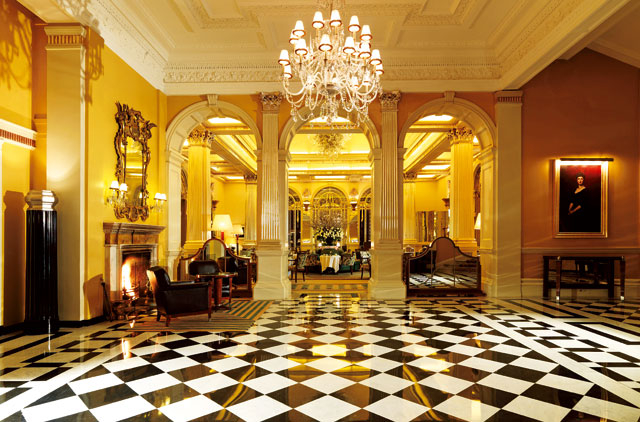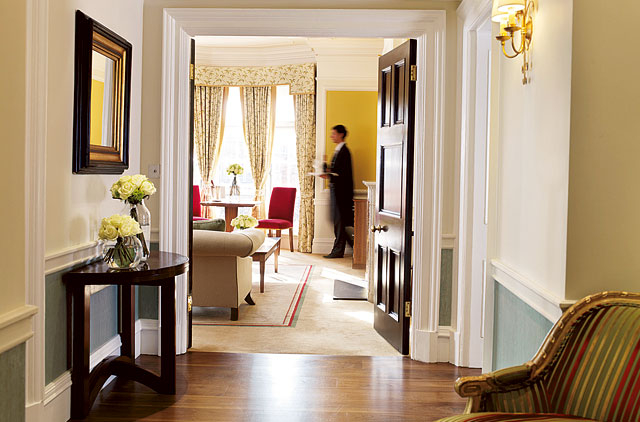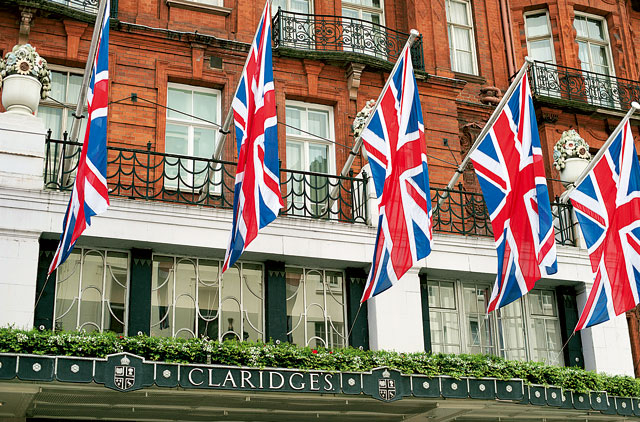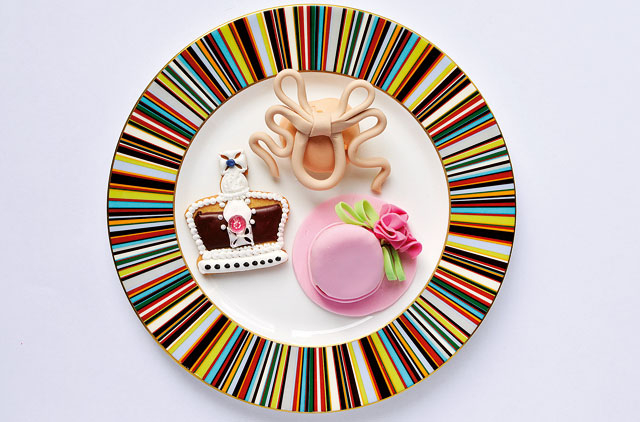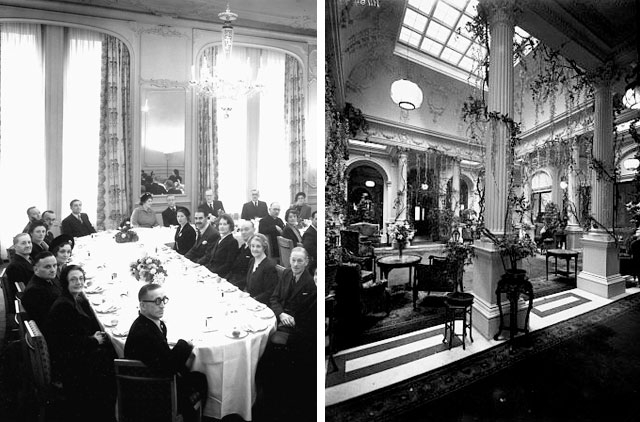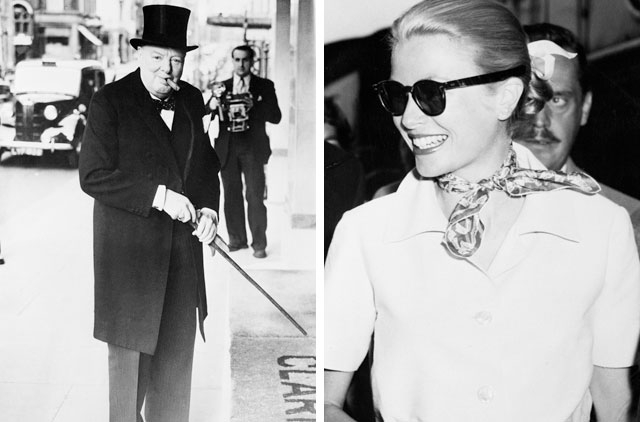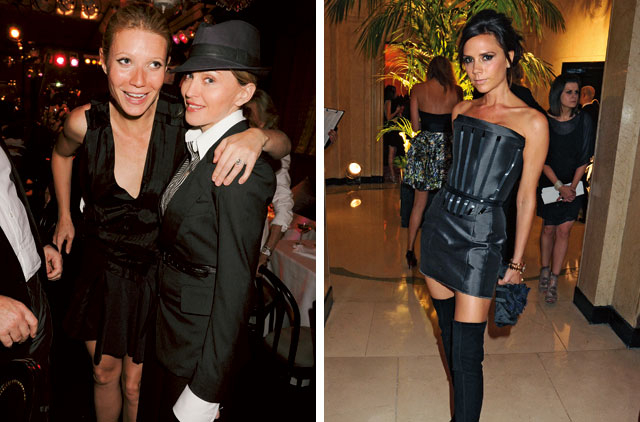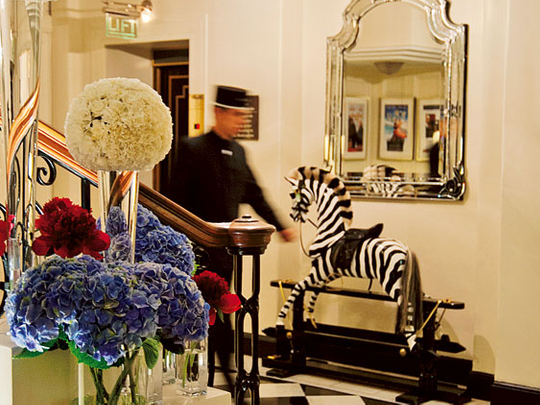
Try this: Say the words ‘royalty' and ‘London' aloud to yourself and piece together the images that form inside your head. You've probably imagined a magnificent hallway lined with footmen or butlers, an enormous high-ceilinged room with tables that never seem to end, well-dressed diners enjoying an exquisite spread, or possibly the Queen of England herself. Royalty and opulence go hand in hand, and Claridge's hotel in London - jokingly referred to as an ‘extension of Buckingham Palace' - couldn't get much more regal if it tried.
While the majority of Europe's monarchies reside only in the history books, England holds on to its queen with a quiet fondness, which had bloomed into uncharacteristically demonstrative patriotism when I arrived at the hotel during the celebration of her diamond jubilee earlier this month.
But beneath the display of Union Jacks across the hotel facade, the quintessentially English qualities of restraint and refinement still reign in the hotel's interior, and my stay at Claridge's turned into both a fascinating journey into the heritage of the hotel, and a gripping insight into the artistic details that have gone into designing the building.
Heritage and celebrity
Fashionable London has always flocked to Claridge's gilded doors. Bought in 1854 by Mr and Mrs William Claridge, the hotel received the ultimate seal of approval in 1860 when Queen Victoria visited her friend, Empress Eugénie of France, who was using Claridge's as her winter quarters.
So began a tradition of royal visits that continues to this day - Prince William and Kate Middleton were pictured attending a private dinner there just this May.
In 1893 Claridge's was bought by Richard d'Oyly Carte, owner of the Savoy hotel, who commissioned the designer of Harrods, CW Stephens, to demolish the original buildings and erect the elegant seven-storey hotel that stands today. The new Claridge's opened for business in 1898.
Since then its luxurious suites and rooms have borne witness to many momentous occasions.
While the Second World War raged in Europe, many exiled kings and queens, including the King of Norway and the Queen of the Netherlands, found a safe haven in Claridge's - so many, in fact, that when a diplomat telephoned the hotel in 1947 and asked to speak to the King, the response was "Certainly sir, but which one?"
On 17 July 1945, Claridge's suite 212 officially became a part of Yugoslavia for the day. In an unconventional gesture of British courtesy, the prime minister at the time, Winston Churchill, made the concession because it was the only way for Crown Prince Alexander, heir to the throne, to be born on Yugoslav soil - according to legend, Claridge's staff placed a clod of Yugoslav earth under the queen's bed during her labour.
But it's not just royalty. The hotel's guestbook reads like a movie bill poster from the golden years of Hollywood - during the 1950s, screen legends Grace Kelly, Audrey Hepburn, Cary Grant and Bing Crosby all strolled through the Claridge's lobby - but Katharine Hepburn had to use the staff entrance. She was barred from the lobby for wearing trousers, which was still highly unconventional for ladies at the time.
In 1956 the then premier of the Soviet Union, Bulganin, and first secretary of the Communist Party of the Soviet Union, Khrushchev, made Claridge's their headquarters during their controversial stay in London, and they held a party in the Royal Suite that is said to have got so crowded that ‘buttons popped off jackets'.
Its status as a high-end party venue continues to this day - the Claridge's penthouse is where Kate Moss chose to celebrate her 30th birthday and A-listers from Victoria Beckham to Madonna and Gwyneth Paltrow have attended functions held within its walls.
Equally glamorous as the clientele, the building itself has much to say about British history. Its unique architectural and design quirks tell the story of 1920s London - the opulence and dramatic design of the interior can be seen as a response to the years of austerity throughout the First World War, reflecting a desire for excitement and the new-found prosperity of the period.
While many of the original 19th-century features are preserved today, the Art Deco period is when Claridge's received its most major redesign. This was the time when Claridge's added its ballroom and carried out extensive refurbishment on its restaurant, entrance and several rooms, all in a style described as ‘Regency Vogue'.
Over the years redesign and refurbishment continued, culminating in Thierry Despont - a New York interior designer known for his work on the centennial restoration of the Statue of Liberty - being invited to restore the ground floor in 1998, creating Gordon Ramsay at Claridge's, the intimate Fumoir, the elegant Foyer and Reading Room, with the 19th century and art deco details being enhanced by the Dale Chihuly light sculpture which graces the heart of the hotel.
A taste of the high life
Of course, with the hotel having such an illustrious reputation, I had very high expectations for my visit. I stayed in one of the Linley suites - designed by the company founded by British designer and nephew of Queen Elizabeth II, David Viscount Linley - which was upholstered in classic, understated colours and merged elements of traditional and art deco design. The uncompromising attention to detail in every area fascinated me, and I particularly appreciated the interplay of natural light and shadow sifting through the curtains and enjoyed photographing the many quiet nooks and crannies dotted throughout the building.
Guests in every suite are designated a personal butler for the duration of their stay and special touches such as the luxurious Bamford Natural and Organic toiletries and delicious artisan chocolates - mine were delicately decorated with a Union Jack design for the jubilee - ensure any guest feels like royalty.
Another delicious highlight was the ‘designer' Prêt-à-Portea afternoon tea at the Berkeley hotel in Knightsbridge. The Berkley's tea blends history, fashion and indulgence in a menu of delicate cakes and pastries presented in the season's catwalk colours and styles. There are no words to describe this experience except as being an afternoon of ‘eating art.' A single tray of three biscuits or cakes takes an entire day to create. To top it all, for a special jubilee feast, the chefs had fashioned a set of edible goodies including sweet delicacies in the shape of the Queen's coronation crown and the headline-grabbing fascinator worn by Princess Beatrice at the Royal Wedding last year.
Sated with rich food, fine design and feeling full of a sense of history, my short stay at this heritage hotel left me feeling truly a part of a legacy of luxury.
As told to Mark Edward Alphonsus
Travel in style
British Airways has several solutions to offer the long-haul traveller looking for a more comfortable flight.
Club World
These business-class seats transform into a completely flat bed with the armrests folding flat by the sides to create more room. Passengers can also enjoy the Club Kitchen, which offers a variety of snacks and drinks, while indulging in the airport spa and relaxing in the club lounge on arrival at the airport.
First Class
Passengers are treated to a suite with a seat that flattens into 198-centimetre bed; access to food as and when required with breakfast; a choice of snacks; à la carte dining and an afternoon tea service.
Use of a personal wardrobe and shoe cupboard, side table and mood lighting in-flight are available.
On arrival, you have access to luxury lounges with WiFi, restaurants and other amenities.
Galleries Arrivals Lounge
Available to Club World and First Class passengers. This includes a news zone and access to the Elemis Travel Spa within the lounge, which has a number of treatment and shower rooms.


